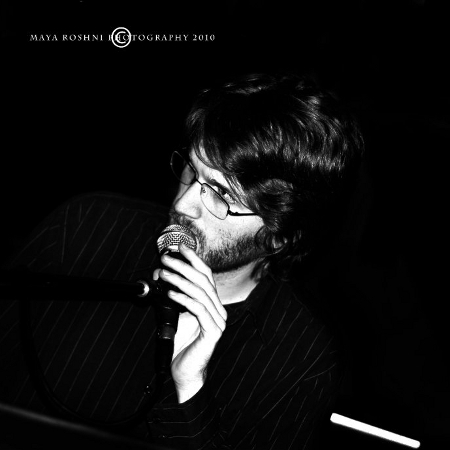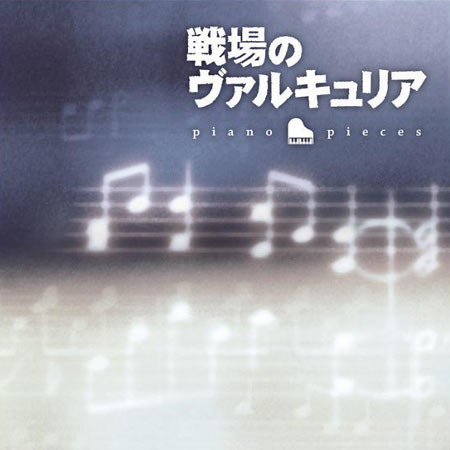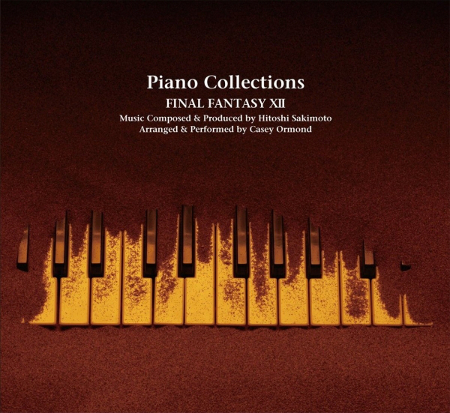Casey Ormond Interview: Final Fantasy XII Piano Collections
Casey Ormond is a Perth-based composer, arranger, and pianist. He came to the attention of Hitoshi Sakimoto with the help of our own Don Kotowski, leading him to produce two official piano albums, the Valkyria Chronicles Piano Pieces and Final Fantasy XII Piano Collections. Both amazed listeners for the way they transformed Hitoshi Sakimoto’s complex orchestral original pieces into a well-rounded emotional piano arrangements.
In this interview, Casey Ormond discusses his background and shares his experiences working on these albums. He focuses on his writing process — noting how he fully absorbed the original pieces, decided the features to emphasise and styles to use, and developed a flow in his arrangements. He also provides an outlook, noting how he wants people to start learning the sheet music for his arrangements in the future.
Interview Credits
Interview Subject: Casey Ormond
Interviewer: Chris Greening
Editor: Chris Greening
Coordination: Chris Greening, Simon Elchlepp
Interview Content
Chris: Casey Ormond, it’s an honour to have the opportunity to talk to you. First of all, could you tell us a bit about yourself? What education and experiences led you towards becoming a professional pianist?
Casey Ormond: I was very musical from a young age, but it wasn’t until high school when I decided to pursue music as my career. I learned just about every Ben Folds Five song, got into jazz and video game music, and wrote a lot of original music as well. After I graduated, I studied Jazz at the West Australian Academy of Performing Arts. Throughout the course, I was still very much into VGM — I even made an arrangement of “Travelling Agency” from FFX for jazz band! After university, I continued to play and arrange VGM as a hobby.

Chris: Your piano arrangements reveal that you’re passionate about a range of styles, including classical, modernist, and jazz approaches. Could you tell us more about the composers and pianists that have influenced you over the years? You have also revealed that you’re a big fan of the Final Fantasy Piano Collections series. How have these albums inspired you — do you have any particular favourite albums and arrangements?
Casey Ormond: I was very into pop piano from a young age, stuff like Billy Joel and Ben Folds. Later on, I became very influenced by jazz pianists like Thelonious Monk and Brad Mehldau, as well as Australian artists like Grant Windsor and Russell Holmes (who I was also lucky enough to have as teachers). I have a fairly limited classical background — many of the classical, romantic and modern styles I learned were from the arrangements of Masashi Hamauzu and Shiro Hamaguchi, in the Final Fantasy Piano Collections series.
I was already a big fan of Uematsu, especially the versatility of his writing. This versatility carried over to the Piano Collections series — there’s jazz, pop ballads, blues, latin, classical and everything in between. Learning those songs over the years gave me a very rounded appreciation of what the piano is capable of, and those albums continue to be a great source of inspiration. It’s really hard to pick a favourite, but my top three (in no particular order) would be VII, IX and X. “Secret Library Daguerreo”, “Besaid Island”, “Assault”, “Final Fantasy VII Main Theme”… these songs are pretty much perfect. Listening to them while writing was inspiring but also daunting — I knew I had to try to write music on par with these legendary albums.
Chris: You first produced music for Hitoshi Sakimoto on the Valkyria Chronicles Piano Pieces released last year, before producing a follow-up album dedicated to Final Fantasy XII. How did the two of you come to work together and what was it like to work alongside him? What was the process of getting the Final Fantasy XII Piano Collections commissioned after it was forgotten for so long?
Casey Ormond: In 2009, I made an arrangement of the “Skycity of Bhujerba”, as an unofficial fan tribute. Don Kotowski passed it on to Hitoshi Sakimoto through twitter, who enjoyed the arrangement and asked to keep in touch. It was pretty unreal to have this fan project of mine validated by one of my musical idols! After that, I was inspired to write more Sakimoto piano arrangements, and I continued to send him my work. We first met up in 2010 in Sydney, where we talked about an official collaboration. That was when the idea of a Valkyria Chronicles piano album was first suggested — and at the start of 2011, it was made official.
I think the Valkyria Chronicles Piano Pieces helped to show people that piano arrangements of Sakimoto’s music were possible — and the success of that project also added to my own credibility as an arranger, a must for a high-profile series like the Final Fantasy Piano Collections. I think that the 25th anniversary of Final Fantasy was also an ideal time to revisit the music from FFXII.
Sakimoto-san is great to work with — very supportive and open to ideas. In both the Final Fantasy XII Piano Collections and Valkyria Chronicles Piano Pieces, I reworked his music in some unexpected ways, but the changes were always met with enthusiasm and constructive feedback. He’s a cool guy!
Chris: Perhaps owing to your jazz background, your arrangements tend to have a natural flow and almost improvisatory feel to them (even those that aren’t traditionally jazz-styled). To what extent do you feel that is true? Could you tell us more about your process of producing an arrangement from conception to completion?
Casey Ormond: Writing, my favourite topic! A “flow” is actually the best term to use when describing what I strive for in my arrangements. The music I’m writing is multifaceted — it needs to stoke the imagination of the listener (who recalls the original), retain Sakimoto’s sound, AND offer something new through my own musicality.
To write an interesting arrangement, the original song has to be completely internalised. You know you’ve internalised a song when you can sing the melody, solos, drum breaks, everything without listening to the music itself. Being a fan of the games I’m arranging for gives me a headstart in developing this familiarity. Out of this familiarity I can make a basic piano reduction of the original, then I’ll stop listening to the track entirely. This lets me combine the song with other songs and styles I’ve internalised, both unconsciously and through experimentation.
If you think of all the music you’ve ever listened to or played as a “pool” of ideas, then I’m allowing the song to sink from the surface of that pool to where the rest of my musicality lies. The best ideas arise when the song you’re arranging can “flow” through your musicality in this way. It’s similar to reading a lead sheet for a jazz tune — you have the melody and chords, and if your musical vocabulary is strong and varied enough, you’ll create something unique.
It’s a slow, sometimes frustrating, but ultimately rewarding process, that creates a lot of material, though not all of it is usable. The hardest part is choosing what to cut out, otherwise I’ll end up with a 7-minute arrangement with no real theme to it.

Chris: Your albums have covered the deep storyline of Final Fantasy XII and the entire trilogy forValkyria Chronicles. To what extent is it important to you to convey the in-game worlds and storylines? Do you intend your albums to primarily serve as a tribute to the games or a stand-alone experience in their own right?
Casey Ormond: Many of the arrangements are inspired by my in-game experiences with the songs. When working out a concept for the arrangement I usually decide whether to highlight the in-game context of the song, or to create an ‘alternate’ theme. For songs like “Those Who Succeeded” and “The Archadian Empire”, the mood of the original piece is expanded upon. The ‘alternate’ themes come from a desire to show a different ‘side’ of a character or event.
For example, with “Eruyt Village”, the original track had a very pianistic framework — low harp arpeggios and a soaring melody. Asako Niwa had already made a lovely transcription around that framework, so I wanted to try a different idea. The concept was to make “Fran’s version” of the theme — darker, but more worldly and introspective — to reflect her feelings of leaving her homeland for a life of adventure. “Dalmasca Estersand” was also going to be an ‘alternate’ arrangement, focusing on the ‘lullaby’ style heard in the intro, but I ultimately decided that it needed to retain the energy and excitement of the original.
Also, as I worked on these arrangements they started to grow personalities of their own — for example, “Nameless Heroes” is as much a tribute to my love of the pop-piano ballad as it is the characters of Valkyria Chronicles III. The arrangements are a celebration of the music with the games’ fans, but are also quite personal.
Chris: Sakimoto’s music ranks as some the most complex and individualistic game music ever produced. As a result, many have assumed his music could never be arranged for solo piano, but you have proved otherwise. Does the nature of Sakimoto’s music present challenges to you when arranging his music? Though your albums tend to focus on the softer sides of Sakimoto’s music, you’ve also interpreted more heavy material, such as “The Dalmasca Estersand” and “Theme of the Empire”. How do you capture the weight and motion of such pieces despite the transition from orchestra to piano?
Casey Ormond: Sakimoto has an unmistakeable style, which I believe is a quality that makes a composer irresistible to arrange. It’s exciting to try and capture that sound on a solo instrument, but it can take some time to work out the most vital elements of the music.
Since Sakimoto’s tracks are so musically dense, you can drive yourself crazy by second-guessing what should or shouldn’t go into the arrangement. For example, in “Desperate Fight”, almost all of the melody is harmonised, so the arrangement highlights the chord movement to capture Sakimoto’s sound. Whereas in “Skycity of Bhujerba” I found the melody to be the most important element, despite the insistent, bouncy chords of the original. I think that, after the Valkyria Chronicles Piano Pieces, both my writing and playing adapted to Sakimoto’s style, which made it easier to approach the music of FFXII.
As for the heavy tracks you mentioned, they do require a very “full” arranging style, but not necessarily a virtuosic one. In the busier arrangements I tend to split the hands into two voices, to match the complexity of the original. A lighter, contrasting section is important in these heavier songs, so as not to tire out the listener (or the player, in fact). The piano’s range is well suited for these kinds of songs, but I think if the arrangement gets too intense it can be alienating to the listener. Space and simplicity in a Sakimoto arrangement can also be effective because it’s so different to the original’s intensity.
Chris: While all your arrangements take liberty on their originals, some are complete transformations. Obvious examples include the jazz take on Final Fantasy XII‘s “To the Place of the Gods” or the Latin American influence of Valkyria Chronicles II‘s “Theme of Valkyria”. What is the creative process that leads you to produce such arrangements? How do you manage to pull it off?
Casey Ormond: I think exploring a variety of styles is in the spirit of the FF Piano Collections series, so that was the approach I decided on. The Final Fantasy series, and games in general, have always been a good way to experience new musical styles. The piano arrangements too should expand the listener’s musical vocabulary. As I mentioned before when explaining my writing method, I like to experiment with the styles I have internalised, and if an idea really leaps out at me, that usually means it’s the right one.
“To The Place of The Gods” went through many scrapped iterations before the jazz angle clicked for me. On the other hand when I stripped “Theme of Valkyria” down to just the melody, the Latin piano approach seemed obvious. There are a few songs where I challenged myself to write in a certain style — “Nalbina Fortress” and “Valkyria Chronicles 3 Main Theme” come to mind. The ‘jumping in the deep end’ approach, with an unfamiliar style, is also a good way to kickstart your creativity.
Chris: You also personally performed the two piano albums in special recording sessions. Could you share some memories of these sessions? How did you approach the performances and what did you aim to emphasise?
Casey Ormond: I had a great team supporting me during those sessions, including Sakimoto himself who flew to Perth to oversee the recordings. We chose a Yamaha grand piano and recorded at Crank Recording, one of the top studios in Australia. It was a very rewarding experience, and we put a lot of thought into how to make each song’s mix unique, in order to match the variety of styles in the arrangements. We actually finished the recordings on my birthday, and went out to celebrate afterwards — that was a pretty memorable birthday!
Chris: You closed the Final Fantasy XII Piano Collections with “The Skycity of Bhujerba”, which you mentioned was the piece that first acquainted you with Hitoshi Sakimoto. Was this intended? How does it feel to have now come round full-circle?
Casey Omond: Yes, it’s pretty special to have that song as the closer on the album, although for me, this experience comes ‘full-circle’ once people start learning, performing, and teaching the sheet music themselves. Like other albums in the series, the sheet music for the Final Fantasy XII Piano Collections is now available for fans to play. I hope to continue the tradition of inspiring piano students with Final Fantasy’s music.

Chris: It would be interesting to hear about your other ambitions in the realm of game music. Hitoshi Sakimoto has many other defining scores, spanning the grandiose Final Fantasy Tactics, the broodingVagrant Story, and the whimsical Opoona. Would you be interested in producing more piano albums based on his works in future? Are there any that you are particularly keen to tackle? There has also been a trend, particularly in Japan, of piano arrangements of game music being performed live. Would you ever be interested in doing this for these two piano albums?
Casey Ormond: The Ivalice franchise is full of amazing music. Tactics Advance is actually the first Sakimoto soundtrack that I got into. I would definitely love to continue exploring Ivalice on the piano! As for live video game music, I loved how it is becoming a common thing world-wide. It would be great to be a part of that trend!
Chris: Many thanks for your time today, Casey Ormond. Is there anything else you’d like to say about yourself or your works? Do you have any messages to your fans around the world?
Casey Ormond: Thanks for having me! The easiest way to get the album is on iTunes. The sheet musicfor the album has just been released too, on the 23rd of December. I’m really looking forward to people learning the songs! Thanks to everyone for checking out the album, and especially to the fans, family and friends who encouraged me long before the ‘dream project’ became real, and continue to now. Also, you can find me at @CaseyOrmond on twitter!
Posted on November 1, 2012 by Chris Greening. Last modified on February 26, 2014.













